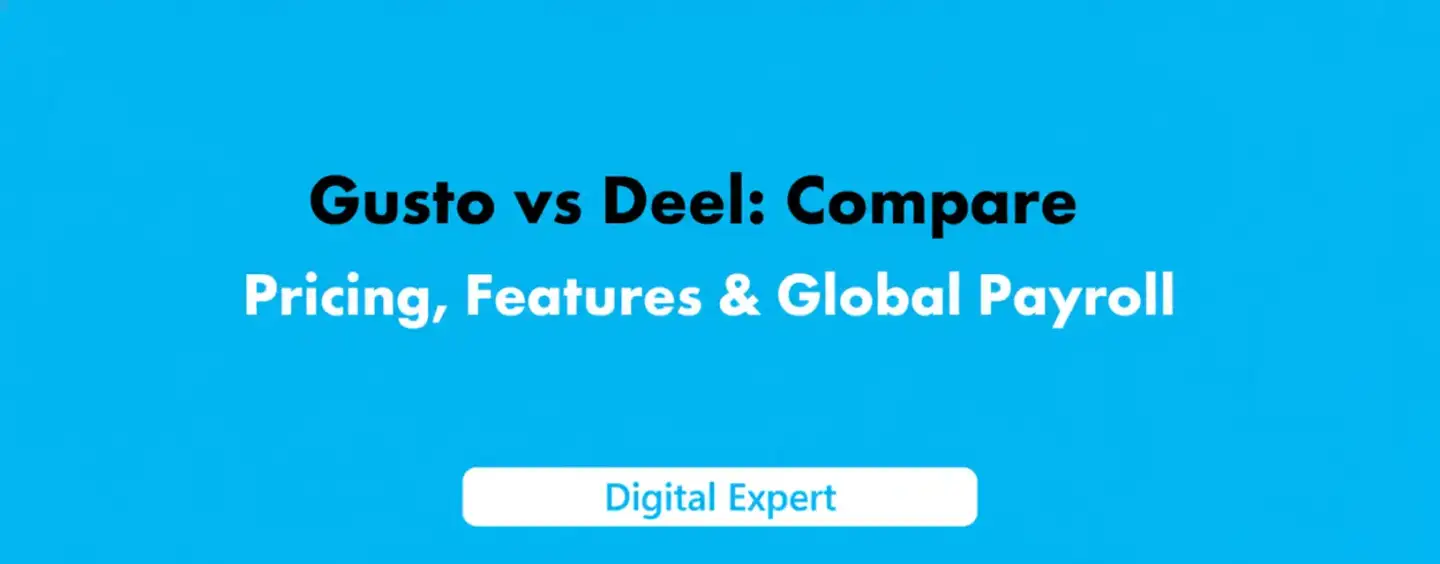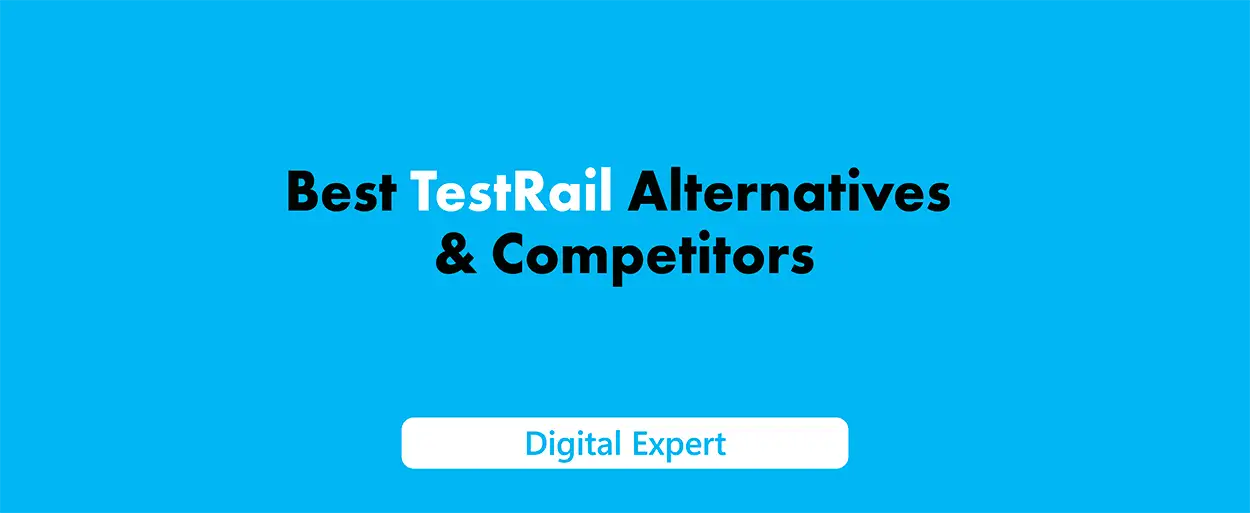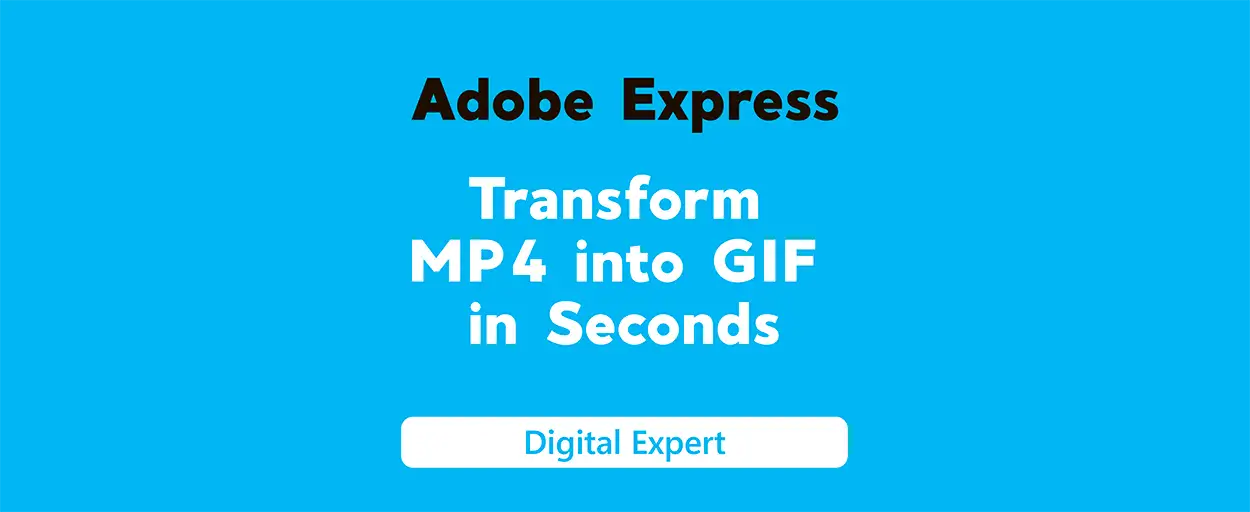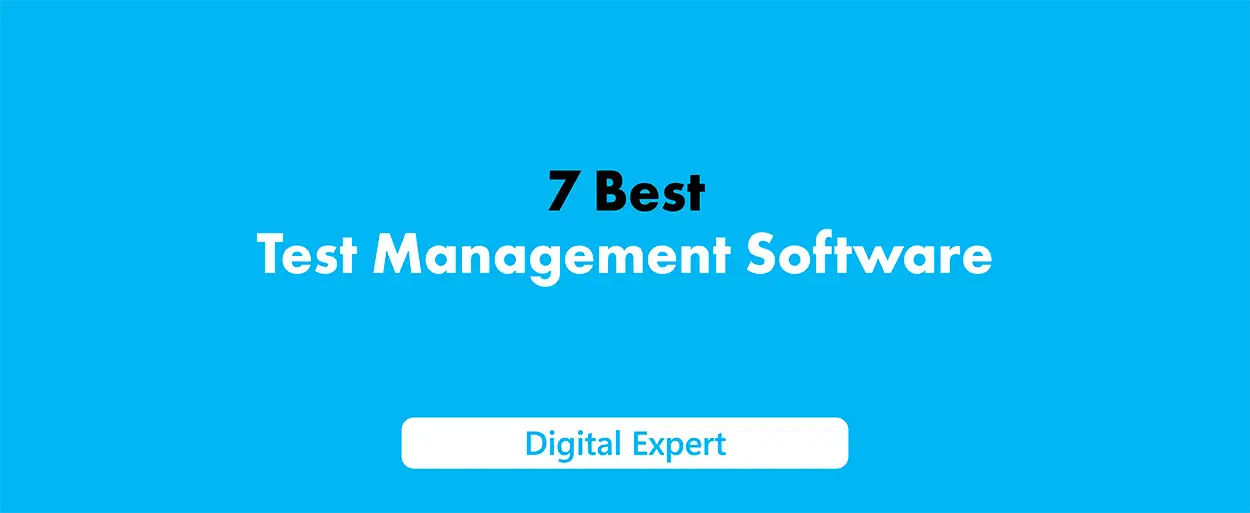On paper, Mailchimp has been around for 20 years, is well-known, can be used with lots of other systems, and has a simple interface. Mailchimp’s plans are well-suited for businesses looking for comprehensive email marketing solutions and features, including advanced email marketing features and various marketing tools. SendPulse, a 2015 startup, retaliates with a multi-channel offensive - combining unique features such as email campaigns, SMS, web-push, chat bot automation and automation features including key features like A/B testing into a single affordable roof. Are you a startup that's growing and looking for a free plan that can grow with you? Are you an established e-commerce store that wants to use smarter automation? This comparison will show you which tool will be the best in 2025.
This is one of the most discussed SendPulse vs Mailchimp comparisons in digital marketing forums this year. No wonder: email marketing still delivers a jaw-dropping $36 return for every $1 spent — higher than any other channel, according to the latest Litmus State of Email 2024 report. With more than 4.6 billion email users worldwide and inbox appointment climbing steadily (Statista, Feb 2025), choosing the right platform can literally make or break your campaign ROI.
Then let us compare and contrast each platform in terms of price, automation horsepower, and production proven performance. Alright, so let us jump in.
TL;DR – Quick Comparison Table
Aspect |
Mailchimp (2025) |
SendPulse (2025) |
Quick Winner |
|---|---|---|---|
Free plan |
Up to 500 contacts & 1 000 sends/mo Pricing |
Up to 500 subscribers & 15 000 sends/mo Pricing |
🟢 SendPulse – 15× more email volume |
Entry paid tier (≈2 500 contacts) |
US $29/mo (Essentials) |
US $18/mo (Standard) |
🟢 SendPulse – ~38 % cheaper |
Email editor & templates |
300+ templates, AI Subject Line Helper |
130+ templates, AMP & drag-and-drop builder |
↔ Draw – depends on AMP need |
Automation workflow |
Visual Customer Journeys; predictive segmentation (higher tiers) |
Automation 360: email + SMS + web-push + chat bots in one flow |
🟢 SendPulse – true multi-channel |
Multi-channel marketing strategy |
Email + landing pages + social ads |
Email + SMS + web push + WhatsApp/Viber chat bots |
🟢 SendPulse – more channels |
transaction email |
Separate add-on (Mandrill) from US $20/mo |
Built-in SMTP on every plan |
🟢 SendPulse – no extra fee |
Integration |
320+ native apps (Shopify, Salesforce, etc.) |
70+ native + Zapier/Make bridge |
🔶 Mailchimp – bigger marketplace |
Deliverability tools |
Send-time optimization, inbox preview (paid add-on) |
Free spam-score check, dedicated IP option |
↔ Both solid; Mailchimp slightly more Artificial Intelligence perks |
Customer support |
Email & live chat (business hours), no phone |
24/7 chat, email & phone, extensive tutorials |
🟢 SendPulse – extra phone & 24/7 |
Ideal for |
Larger lists needing deep analytics & big-brand ecosystem |
Start-ups & SMBs seeking affordable multi-channel growth |
🟢 SendPulse |
Bottom line: SendPulse takes the prize if what you need is affordable, multi-channel automation with human assistance on speed-dial. Mailchimp continues to excel in businesses that lust after massive integration libraries and cutting-edge Artificial Intelligence analytics - at a higher cost.
Overview of Mailchimp
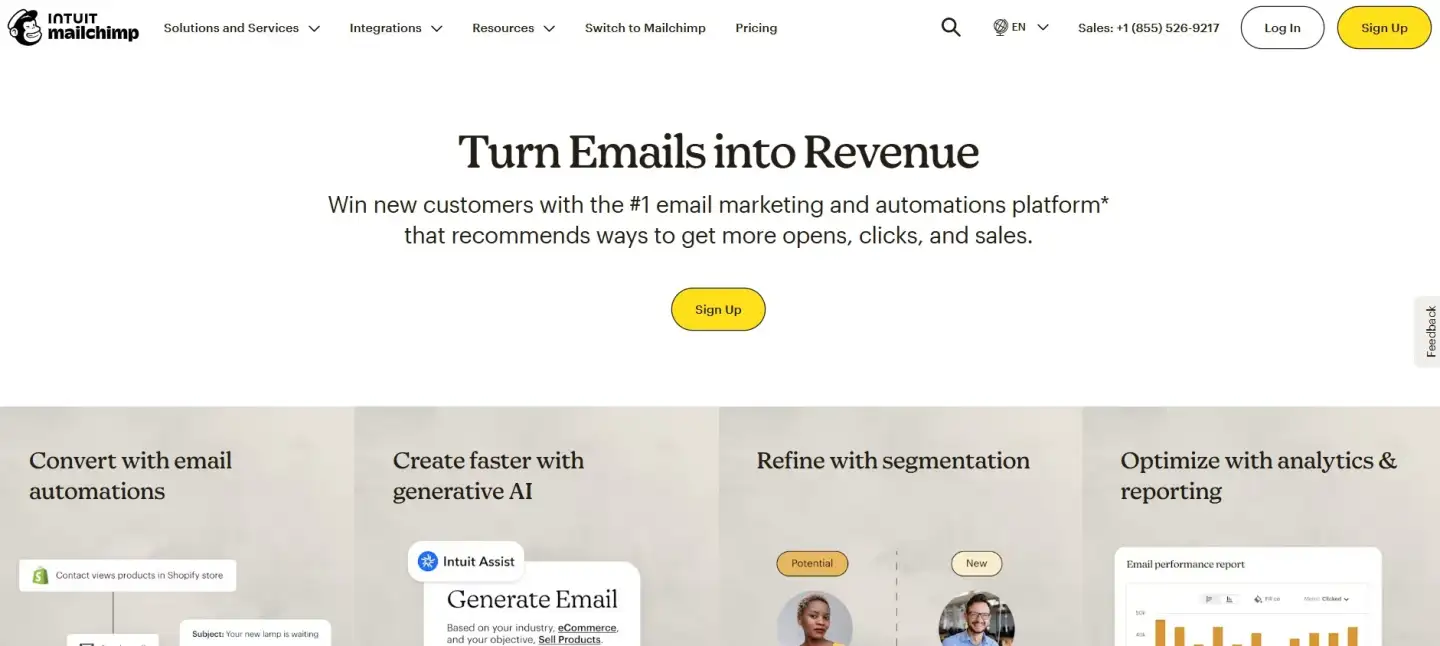
Mailchimp is an email-marketing platform founded in 2001 and acquired by Intuit in 2021, in a deal valued at $12 billion, Mailchimp has become one of the most well-known platforms of its kind in the world, with an estimated 13 million users in 2024. That mission of the company, namely, to help small businesses grow, appears in the refined interface that encompasses email creation, rudimentary CRM, landing pages, and even social ads in a single brand-friendly dwelling.
The center of Mailchimp is a versatile drag-and-drop email creator that is supported by 300+ mobile-responsive templates. On top of that marketers can add A/B tests, dynamic content blocks and AI-powered suggestions of subject lines that increase open rates. Visual Customer Journey Builder allows you to chain together multi-step automation with branching logic on larger campaigns, predictive segmentation and send-time optimization use machine learning to find the right inbox at the right time.
Another advantage of Mailchimp is that it has 320+ native Integration, whether it is Shopify and WooCommerce or Salesforce and QuickBooks, in addition to granular audience insights dashboards, which break out performance by device, location, and revenue attribution. The trade-off? Those marquee features reside on more expensive plans, and new users occasionally share an more intense learning experience getting to grips with the constantly growing set of tools in Mailchimp. When it comes to big lists, or teams that require advanced analytics and access to a huge app market, though, Mailchimp is a serious, enterprise-capable option.
Overview of SendPulse
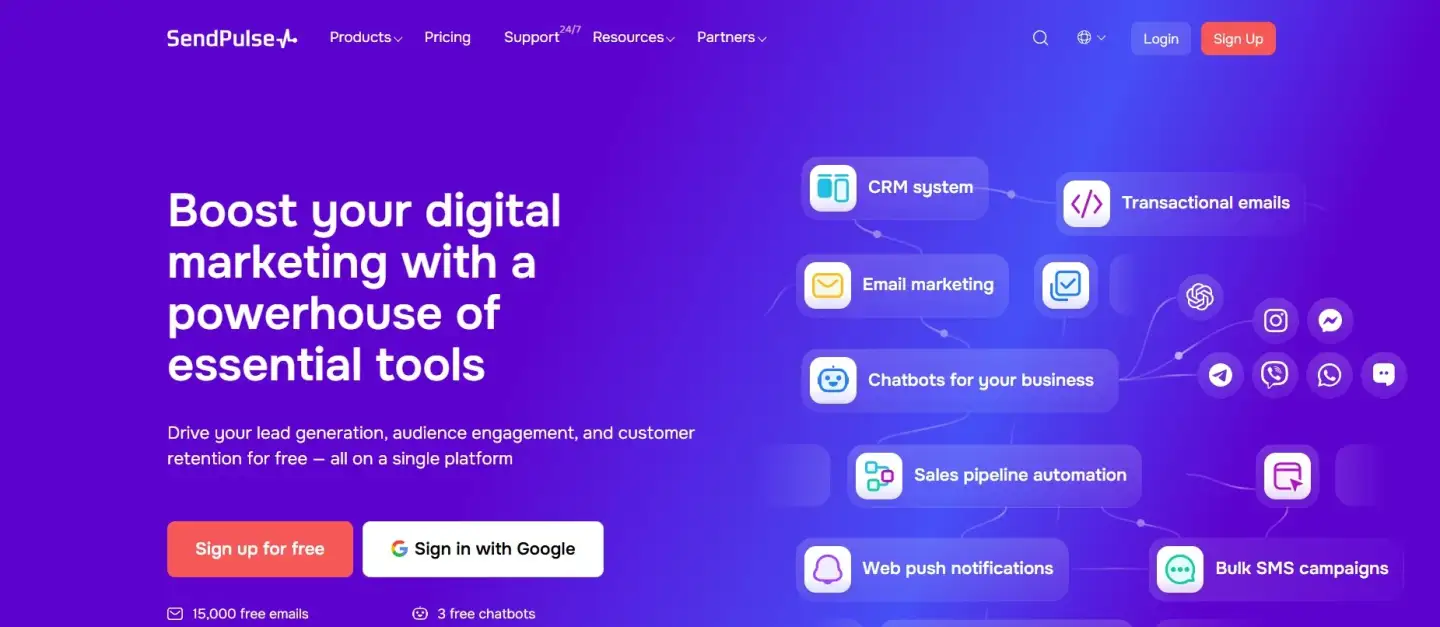
SendPulse is a project that was launched in 2015. It started as a tool for sending emails, but it has grown into a marketing platform that is used by marketers all over the world. In 2024, SendPulse said that over 1.3 million marketers use their platform (SendPulse press release, 2024). Since the beginning, the company has had an all-in-one mentality where email, SMS, web-push notifications, and even WhatsApp / Viber chat bots can be rolled out within the same workspace without any additional plugins.
The main event is Automation 360, a visual workflow builder that allows you to initiate an email, text or push notification based on the same user trigger - e.g. abandoned cart email ➔ SMS reminder ➔ push discount. An AMP-powered drag-and-drop email builder lets you drop surveys or min-checkout forms directly into the inbox, and the included SMTP service handles transaction emails without the Mandrill-style per-add-on charges other competitors will tack on.
SendPulse is great when it comes to accessibility. The free plan allows you to send 15,000 emails per month to 500 subscribers. Paid plans start at around 18 dollars per month for 2,500 contacts. All plans include 24/7 chat and phone customer support. Then throw in easy reporting, an expanding library of 70+ Integration (with Zapier filling in the gaps) and you have a low cost growth engine that is as at home with start-ups and SMBs as it is at scale with midsize e-commerce brands.
Ease of Use & UI
A single look at the user interface narrates two stories. Mailchimp surprised nothing with its appearance, taking on a typical SaaS aesthetic of shiny and minimalistic, full of icons, yet the abundance of menus may make one feel like they are in a cockpit. New users tend to switch amongst the Campaigns, Audience, Automation, and Creative Assistant tabs merely to send out one newsletter. That power comes at a price: reviewers on SoftwareAdvice rate Mailchimp’s ease-of-use 4.4/5 (Feb 2025)—respectable, yet many cites a steep learning curve once they dig into advanced segmentation or artificial intelligence automation features.
SendPulse opts to be less flashy. Your core channels of Email, SMS, Web Push, Chat bots are displayed in a row on the homepage dashboard, meaning you are never more than two clicks away in creating a campaign. Its drag-and-drop builder is lighter and Automation 360 builder aligns triggers, conditions, and actions on a single canvas that can be learned by beginners in minutes. Consequently, SendPulse rates a bit better, 4.5/5, in the ease-of-use at the same SoftwareAdvice grid.
Onboarding Snapshot
Mailchimp: It has a guided tour, tooltips, and a 7-step "Create Your First Campaign" wizard. But it's hard to find the settings because they're buried three layers deep.
SendPulse makes it easy. It has a one-page "Create a Campaign" form and helpful hints. There's no complicated multi-step process. You can go from signing up for an account to sending your first message in less than 10 minutes.
The bottom line? If you like to adjust every setting, Mailchimp's panel will keep you busy. But if you want to get started, test things out, and make changes quickly - especially if you're just starting out or have a small business and don't have a lot of time - SendPulse is a great option. It's easy to use and lets you make custom changes to fit your needs.
Email Design & Templates
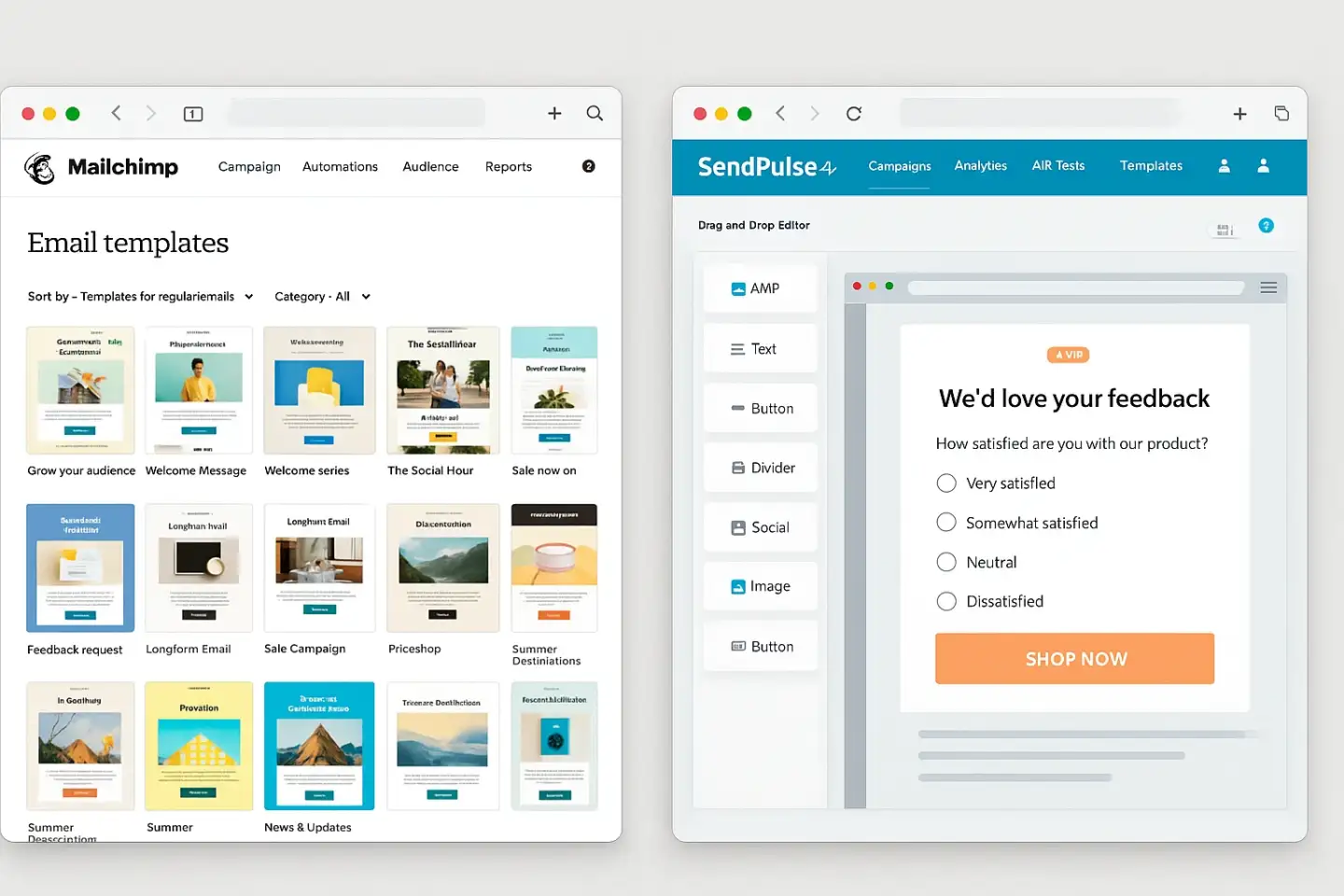
Great email marketing lives or dies on design, and here the two platforms take different tacks.
Mailchimp flaunts a gallery of 300+ responsive templates—from minimalist newsletters to splashy e-commerce promos (Template library). Its drag-and-drop builder lets you stack content blocks, tweak fonts, and even pull brand colors automatically via the Creative Assistant AI, introduced in late-2024 to speed up on-brand design. Power users can switch to a raw HTML editor or paste custom code for pixel-perfect control. Dynamic content blocks and built-in stock imagery sweeten the pot, but advanced features like inbox preview or custom themes kick in only on higher-priced tiers.
SendPulse counters with 130+ mobile-ready templates, all editable in a breezy WYSIWYG interface (Template hub). What it lacks in sheer volume it makes up for in flexibility: import any HTML, clone previous campaigns, or fire up AMP emails to embed polls, product carousels, or even “Buy Now” buttons that work right inside the inbox—no external page load. Brand managers can save custom color palettes and logos as a Brand Kit, while marketers on tight deadlines love the one-click content blocks for headers, footers, and product grids. Every plan (free included) ships with the same design tool kit—no paywall surprise.
Quick Take: If you need a massive template buffet and AI-polished layouts, Mailchimp is a feast. But for interactive AMP content and code-friendly flexibility without up-tier fees, SendPulse steals the show—especially for teams itching to add polls, surveys, or instant checkout right inside the email.
Automation & Workflows
Automation is where campaigns scale themselves, and both platforms bring hefty tool kits—yet with very different philosophies.
Mailchimp: AI-rich Journeys for Deep Email Funnels
Mailchimp’s Customer Journey Builder lets you drag triggers (“sign-up,” “purchase,” “cart update”) onto a visual canvas, branch paths with if/else logic, and sprinkle in AI-powered perks like predictive segmentation and send-time optimization to help grow your mailing list. As of the 2024 upgrade, marketers can chain 30+ triggers and conditions, push contacts into new journeys automatically, and tag them for follow-up. Drip sequences, birthday emails, and win-back flows are a breeze—if you’re on at least the Standard plan (US $29+/mo). Free-tier users get just single-step autoresponders.
SendPulse: Multi-channel Automation 360 in Every Plan
SendPulse Automation 360 offers a similar drag-and-drop canvas but expands the playing field: each workflow can mix email, SMS, web push notifications, and Facebook/WhatsApp chat bots in one timeline. Start with a trigger (“abandoned cart,” “email opened,” “inactive 30 days”) and follow with an SMS reminder, then a final web push notification—all from the same editor. Roughly 20+ triggers cover e-commerce, behavioral, and date-based events, and every plan (including the free tier) unlocks multi-step flows, A/B splits, and real-time stats. Need to tweak on the fly? Click any node; settings panel pops up without reloading the page—great for beginners.
At-a-Glance Comparison
Feature |
Mailchimp |
SendPulse |
|---|---|---|
Visual flow builder |
✅ (Customer Journey) |
✅ (Automation 360) |
Channels in one flow |
Email only |
Email, SMS, Push, Chat bot |
Triggers & conditions |
30+ |
20+ |
AI enhancements |
Predictive segments, send-time |
— (road map Q4 2025) |
A/B split in automation |
Paid tiers only |
Free & paid |
Real-time stats in canvas |
Partial (refresh) |
Live counters |
Takeaway: If your funnel lives and dies strictly by email and you crave AI extras, Mailchimp’s Journeys deliver—just budget for a higher tier. But for marketers who want true multi-channel automation without add-ons or up-charges, SendPulse’s Automation 360 is the clear winner, letting you orchestrate email, SMS, and push in a single, beginner-friendly flow.
Integration Capabilities
Connecting your email engine to the rest of your stack is non-negotiable. Here’s how the two platforms stack up:
Category |
Mailchimp |
SendPulse |
Note |
|---|---|---|---|
Native apps |
320+ in its marketplace (Shopify, WooCommerce, Salesforce, HubSpot, Stripe, Slack, Canva) |
≈70 essentials (WooCommerce, Shopify, WordPress, Magento, Bitrix24, Pipedrive) |
Mailchimp wins on sheer volume |
E-commerce depth |
Deep embeds for Shopify, BigCommerce, WooCommerce (product recommendations, revenue tracking) |
Shopify & WooCommerce plugins plus API snippets; revenue tracking via JS script |
Comparable for SMB stores |
CRM connectors |
Salesforce, HubSpot, Zoho, Insightly (1-click) |
Bitrix24, Pipedrive native; Zoho, HubSpot via Zapier |
Both support full lead sync |
Automation hubs |
Zapier, Make, Tray.io |
Zapier (5 000+ apps), Make |
Zapier evens the field |
REST API & web hooks |
v3.0 JSON REST, robust docs |
JSON REST + SMTP API + web hooks |
Both developer-friendly |
transaction email API |
Mandrill add-on (extra cost) |
Built-in SMTP (no add-on) |
SendPulse advantage |
CMS plugins |
WordPress, Drupal, Squarespace |
WordPress + Joomla |
Parity for most sites |
Flagship Integration in 2025
Mailchimp: Shopify, QuickBooks, Canva Brand Kit, Squarespace Commerce.
SendPulse: WooCommerce, Facebook Messenger Chat bot, Telegram Bot, Bitrix24 CRM sync.
Reality check: Yes, Mailchimp’s marketplace is larger on paper. But SendPulse covers the top e-commerce and CRM connectors small and midsize businesses actually use—and Zapier adds a “universal adapter” for everything else. Unless you rely on a hyper-niche ERP plug-in, you’re unlikely to hit a wall with SendPulse. Plus, its built-in SMTP API means you can fire transaction receipts straight from the same dashboard, something Mailchimp hides behind a separate Mandrill invoice.
Analytics & Reporting
Every send is only as good as the story the numbers tell. Here’s how Mailchimp and SendPulse stack up on campaign analytics:
Reporting Feature |
Mailchimp |
SendPulse |
Edge |
|---|---|---|---|
Real-time dashboard |
Email metrics refresh every few minutes |
Live stats for email, SMS & web-push |
🟢 SendPulse |
Core metrics (open rates, click-through rates, bounces) |
Included on all plans |
Included on all plans |
↔ Tie |
A/B test reports |
Yes, but only on Standard tier & up |
Yes, free tier included |
🟢 SendPulse |
Multi-channel analytics |
Email only (social ads separate) |
Unified view: email + SMS + push + chat bot funnels |
🟢 SendPulse |
ROI tracking / revenue attribution |
Campaign Manager ROI Dashboard (Standard+) |
Revenue tracking tag + Google Analytics integration (all plans) |
🔶 Mailchimp (deeper $$ insights) |
Deliverability tools |
Inbox preview, send-time optimization (paid) |
Spam-score checker, dedicated IP option |
↔ Both solid |
Data export / API |
CSV, Google Data Studio connector |
CSV, JSON API, webhooks |
↔ Tie |
What the Numbers Mean in 2025
Mailchimp fans love the new Campaign Manager ROI Dashboard, which pulls store revenue and ad spend into one panel—great for data-hungry teams willing to pay $29+/mo for Standard.
SendPulse counters with a live multi-channel feed: you can watch your email open rate spike, see SMS clicks in the same graph, and drill down by device without switching screens. For most small businesses, that’s the 80/20 insight they need, and it’s available on the free tier.
Independent reviewers back this up: G2 users rate SendPulse 4.6/5 versus Mailchimp’s 4.2/5.
Bottom line: If you’re an enterprise analyst crunching granular ROI slices, Mailchimp’s paid dashboard is hard to beat. But for everyday marketers who just need clear open-rate, click-through and revenue snapshots across email, SMS and push—all without an upgrade—SendPulse delivers faster, simpler insights.
Pricing & Scalability
Subscribers / Month |
Mailchimp |
SendPulse |
Cost per 1 000 emails* |
|---|---|---|---|
Free plan (500) |
500 contacts, 1 000 sends |
500 subscribers, 15 000 sends |
$0 vs $0 ⇒ 🟢 SendPulse offers 15× email volume |
2 500 contacts |
Essentials $29/mo (25 000 sends) |
Standard $18/mo (30 000 sends) |
$1.16 (MC) vs $0.60 (SP) |
10 000 contacts |
Standard $87/mo (100 000 sends) |
Standard $53/mo (120 000 sends) |
$0.87 (MC) vs $0.44 (SP) |
50 000 contacts |
Premium $350/mo (unlimited sends) |
Pro $219/mo (600 000 sends) |
$0.70 (MC) vs $0.36 (SP) |
*Cost-per-1 000 emails assumes list maxes out send quota (June 2025 pricing pages: Mailchimp | SendPulse).
Scaling Past 100k Subscribers
Mailchimp: Pricing jumps to roughly $600+/mo at 100 k contacts and > $1 100/mo beyond 200 k. Premium plan unlocks multivariate testing, but you’ll pay enterprise rates.
SendPulse: Linear-style slider tops out around $390/mo at 100 k and ≈ $720/mo for 200 k, still including multi-channel Automation 360 and one free dedicated IP per 300 k emails if needed.
Pay-as-You-Go & Annual Discounts
Option |
Mailchimp |
SendPulse |
|---|---|---|
Email credits |
Yes, Pay-As-You-Go (≈ $0.03 / email) |
Yes, Prepaid (≈ $0.01 / email) |
Annual billing |
15 % off |
20 % off |
Non-profit discount |
15 % |
25 % |
Bottom line: For the same list size, SendPulse consistently costs 35-60 % less and lets you push more volume before hitting the next tier. If you foresee explosive list growth—or just hate surprise invoices—SendPulse’s flatter pricing curve and bundled multi-channel features make it easier to scale without sticker shock. Mailchimp remains a solid choice for enterprises that can absorb higher pricing in exchange for niche AI perks, but cost-conscious teams will see faster ROI with SendPulse.
Customer Support
Support Channel |
Mailchimp |
SendPulse |
Edge |
|---|---|---|---|
Live chat |
Paid tiers only, business-hours (M–F, 9 a.m.–5 p.m. ET) |
24/7 chat on every plan, free included |
🟢 SendPulse |
Email / ticket |
All tiers; 30-day limit on Free plan |
All tiers, no limit |
🟢 SendPulse (for free users) |
Phone support |
None (only callback for Enterprise clients) |
Yes, 24/7 phone; Pro & Enterprise get dedicated line |
🟢 SendPulse |
Knowledge base & tutorials |
600+ articles, YouTube playlist |
450+ articles, weekly onboarding webinars |
↔ Tie |
Dedicated success manager |
Premium only (>$350/mo) |
Included on Pro ≥50 k contacts |
🟢 SendPulse (cheaper tier) |
Average first-response time (chat) |
~9 min (2025 Zendesk benchmark) |
<2 min (Intercom dashboard, May 2025) |
🟢 SendPulse |
User rating (Capterra 2025) |
4.2/5 |
4.5/5 |
🟢 SendPulse |
Real-World Scenario
You’re launching a weekend flash sale at 11 p.m. Friday and your RSS-to-email feed breaks. On Mailchimp’s Essentials plan you’ll send a ticket and likely wait until Monday for a reply. On SendPulse—even on the free tier—you can hop on chat, share a screenshot, and often get a live agent within two minutes. Crisis averted, sale saved.
Takeaway: Both brands deliver solid documentation, but SendPulse outguns Mailchimp on human touch—round-the-clock live chat support, real phone lines, and faster first-response times, all without forcing you into a $300-plus premium tier. For businesses that rely on weekend or after-hours campaigns, that great value alone can justify choosing SendPulse.
Conclusion
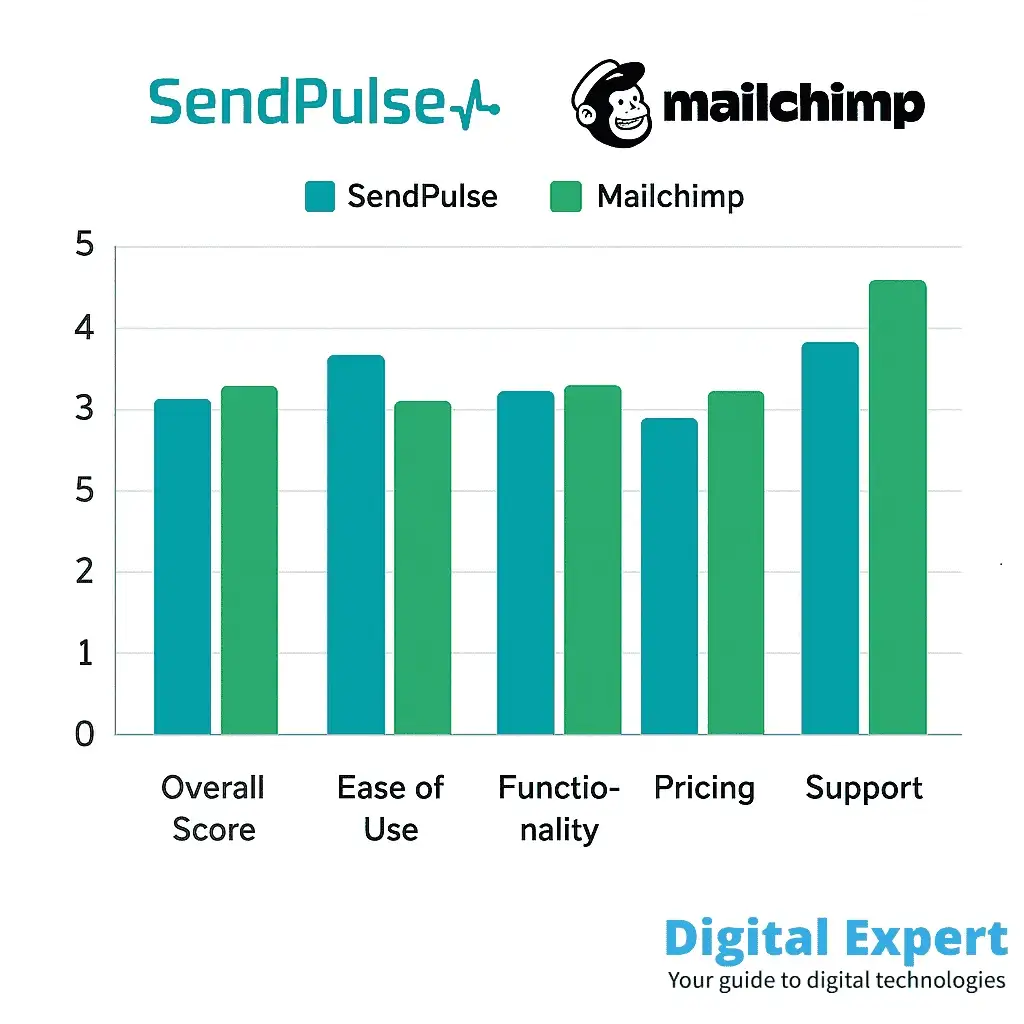
When the dust settles on the SendPulse vs Mailchimp debate, it really boils down to value for money and channel flexibility. Mailchimp earns respect for its polished interface, AI-driven analytics, and a marketplace bursting with Integration—great perks if you’re a data-obsessed enterprise with deep pockets.
But if you’re like most growing businesses—watching costs, craving faster wins, and eager to reach customers on email, SMS, and web-push without juggling extra tools—SendPulse simply gives you more. You get 15× the free-tier sends, multi-channel automation out of the box, 24/7 live support (yes, an actual phone line), and pricing that stays friendly even as your list scales past 50 k contacts. That combo drives a healthier email marketing ROI without surprise invoices.
Bottom line? Choose Mailchimp if you need enterprise-grade Artificial Intelligence features and don’t mind paying premium rates. Choose SendPulse if you want an affordable, all-in-one platform that lets you start small, grow fast, and never lose a wink waiting for support at midnight. The best next step is a quick test drive—spin up each free plan, send a real campaign, and watch which dashboard makes you smile. Happy sending!
FAQ
If you’re watching budget and want to hit customers on more than just email, SendPulse is the go-to alternative. It bundles SMS, web-push, and chat bots with lower pricing and 24/7 phone support—perks Mailchimp hides behind premium tiers.
SendPulse is a multi-channel marketing platform designed for businesses of all sizes that lets you send email newsletters, SMS blasts, web-push notifications, and even WhatsApp or Facebook chat bot messages—all from one dashboard, featuring robust features, including a drag-and-drop editor. Many businesses also use its built-in SMTP service for transaction emails like receipts and password resets.
Mailchimp’s biggest drawbacks are its steep price curve as your list grows due to the number of contacts, a recently capped free plan (500 contacts), and the lack of live phone support. Advanced AI features and multivariate testing are locked behind higher tiers, which can push monthly costs into the enterprise range.
Key competitors include SendPulse, Constant Contact, ActiveCampaign, and Klaviyo. Among them, SendPulse stands out for multi-channel automation and friendlier entry-level pricing.
“There’s no one-size-fits-all,” but if you value multi-channel outreach and cost efficiency, SendPulse ranks best for most small and midsize businesses. Larger enterprises needing deep AI analytics and massive integration libraries may lean toward Mailchimp.
The brand is still Mailchimp. The company was acquired by Intuit in 2021, but it continues to operate under the same name within Intuit’s product family.
SendPulse is a privately held company; its founding team is led by CEO Konstantin Makarov. The firm remains independent and focused solely on multichannel messaging solutions.
SendPulse is headquartered in Wilmington, Delaware, USA, with additional R&D and support offices in Kyiv, Dnipro, and Mexico City.





